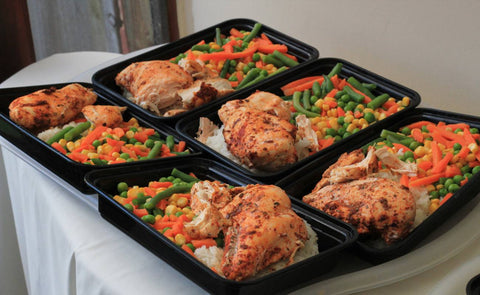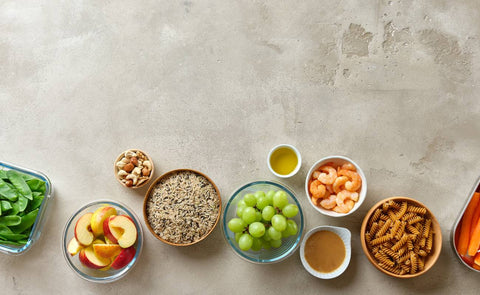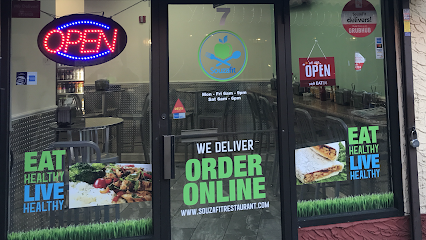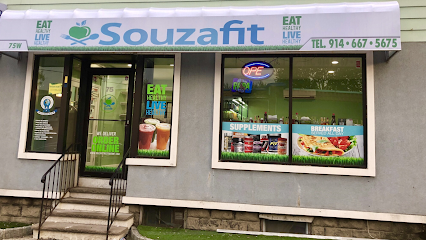To build a nutritious diet, focusing on high-protein meal components is crucial. Protein serves as a fundamental part of every diet, promoting muscle maintenance, energy levels, and overall health. Including a variety of high-protein ingredients in your meals can enhance the nutritional profile of your diet while adding flavor and texture to your dishes.
Exploring different high-protein ingredients helps create diverse and satisfying meals. These ingredients can fit numerous dietary needs and preferences, ensuring you get the nutrients you need. By incorporating these options, you can easily elevate the quality of your meals.
1) Chicken Breast
Chicken breast is a staple ingredient when you're looking to boost your protein intake. It is lean, versatile, and straightforward to cook, making it an excellent choice for many meals. Chicken breast provides about 31 grams of protein per 100 grams, helping to support muscle maintenance and growth.
This ingredient can be grilled, baked, or sautéed, allowing you to adjust it to your taste preferences. You can pair it with a variety of vegetables and grains to create balanced and satisfying meals. It's an adaptable protein source that works well in salads, stir-fries, or as a main dish paired with sides.
Not only is chicken breast high in protein, but it is also relatively low in calories and fat. This makes it suitable for those aiming to manage their weight while ensuring adequate protein intake. It offers you the flexibility to enjoy flavorful meals that also align with your health goals.
2) Almonds
Almonds are a popular choice for a high-protein snack, providing substantial nutrition in each serving. With 21.2 grams of protein per 100 grams, almonds are among the top plant-based protein sources, making them a great addition to any diet aiming for increased protein intake.
Rich in essential nutrients, almonds offer more than just protein. They are an excellent source of vitamin E, which supports healthy skin and immune function. Additionally, their high fiber content benefits digestive health and can contribute to a feeling of fullness, potentially aiding weight management.
While almonds have impressive protein levels, their proteins are slightly limited in certain amino acids like methionine. It's beneficial to pair them with other protein sources to ensure a complete intake of all essential amino acids. Despite this, including almonds in your meals or as a snack can contribute significantly to your daily nutritional needs.
3) Greek Yogurt
Greek yogurt is a versatile ingredient that offers a substantial protein boost for your meals. With its thick, creamy texture and slightly tangy flavor, it can be incorporated into both sweet and savory dishes.
You can use Greek yogurt as a protein-packed base for smoothies and breakfast bowls, blending it with fruits or granola for a satisfying start to your day. It works well in savory dips and dressings, replacing higher-fat options while still delivering rich taste.
In cooking, Greek yogurt can serve as a substitute for ingredients like mayonnaise or sour cream, reducing fat content while maintaining a creamy consistency. Consider mixing it with herbs and spices for a flavorful sauce or dip.
Using Greek yogurt in baked goods such as muffins or pancakes helps create a moist texture, while naturally boosting their protein content. You can also enjoy it straight from the container with your choice of toppings like nuts, seeds, or honey.
Embrace the versatility of Greek yogurt and elevate your meals with its high protein content. This ingredient not only enhances flavor but also adds nutritional value, making it a valuable addition to your culinary repertoire.
4) Quinoa
Quinoa is an excellent high-protein ingredient often celebrated for its versatility and nutritional value. It contains all nine essential amino acids, making it a complete protein source, which is beneficial for plant-based diets.
Incorporating quinoa into your meals can enhance the protein content effortlessly. It is easy to cook and pairs well with various dishes, from salads to hearty bowls.
For those looking to manage calorie intake while boosting protein, quinoa offers an ideal solution. It provides a satisfying balance of macronutrients without being calorie dense.
You can find quinoa in several varieties like white, red, and black, each offering slightly different textures and flavors. This choice allows you to tailor your dishes to your taste preferences and meal needs.
Preparing quinoa is straightforward. Rinse it under cold water to remove bitterness, then simmer it until it absorbs the water. It is ready to enhance your meal in no time.
5) Lentils
Lentils are a fantastic option if you're looking to boost the protein content of your meals. These nutrient-dense legumes are budget-friendly and easy to prepare. One cup of cooked lentils typically contains about 18 grams of protein, making them a powerhouse ingredient in a protein-rich diet.
You can incorporate lentils into a variety of dishes. From soups and stews to salads and even baked goods, their versatility is impressive. Lentils also pair well with numerous spices and flavor profiles, allowing you to create diverse meals that satisfy the palate.
In addition to protein, lentils are rich in fiber, which can aid in digestion and help you feel full. They also provide essential vitamins and minerals such as iron and folate, contributing to overall nutritional balance. Lentils come in various types, including green, brown, red, and black, each offering slightly different textures and flavors.
For plant-based diets, lentils are an excellent meat substitute. They can be used in dishes such as lentil burgers, tacos, or curries. Whether you're vegetarian, vegan, or simply looking to reduce meat intake, lentils are a valuable ingredient to incorporate into your meals.
6) Tofu
Tofu is a staple in plant-based diets, renowned for its high protein content and versatility. A 3.5-ounce serving typically contains about 8 grams of protein, making it a strong contender for those looking to increase protein intake without consuming animal products.
You can enjoy tofu in a variety of dishes, from stir-fries and soups to smoothies and desserts. Its mild flavor and adaptable texture allow it to absorb the flavors of the ingredients it is cooked with, offering endless culinary possibilities.
This ingredient is also economical and accessible, often found in the refrigerated section of grocery stores. Tofu's production involves curdling fresh soy milk and pressing it into a solid block, a process that has been utilized for centuries in Eastern and Southern-Asian cuisines.
7) Cottage Cheese
Cottage cheese is a versatile ingredient that can easily boost the protein content of your meals. Packed with protein, it is an excellent choice for those aiming to increase their protein intake.
Its mild flavor works well in various dishes. You can use it in savory recipes like lasagna and mac and cheese or sweeten it with fruits and honey for a nutritious breakfast option.
Cottage cheese is not only high in protein but also provides a good source of calcium, which is essential for bone health. It can also serve as a lower-calorie alternative to cheese in many recipes.
Incorporating cottage cheese into your diet can be as simple as adding it to salads or using it as a spread or dip. Be mindful of the sodium content, as some varieties contain higher levels.
For those who enjoy experimenting with recipes, cottage cheese can replace other dairy products like ricotta or cream cheese. Whether blended into a smoothie or baked into a casserole, it enhances the nutritional profile of many dishes.
8) Turkey
Turkey is a fantastic high-protein ingredient that's both versatile and lean. Ground turkey, in particular, is a popular choice for a variety of recipes from stir-fries to casseroles. With around 27 grams of protein per 100 grams, it provides a substantial protein boost without the high fat content often found in other meats.
Incorporating turkey into your meals can be simple and delicious. Consider using turkey in a stir-fry with vegetables and a flavorful teriyaki sauce, making it a quick and satisfying option. Turkey can also be a star ingredient in pasta dishes or casseroles, offering a lighter alternative to beef while maintaining a similar taste profile.
For meal prep, turkey is an excellent option. You can cook a big batch and use it in different recipes throughout the week, such as turkey tacos or burgers. Its mild flavor pairs well with a range of spices and ingredients, allowing for creativity in the kitchen.
Turkey's versatility makes it suitable for various culinary traditions, whether you're making curries, patties, or stews. With a focus on balanced meals, turkey helps you maintain a high-protein diet without compromising on taste or nutrition.
9) Chickpeas
Chickpeas are an excellent source of plant-based protein, making them a versatile ingredient in your diet. They can be used in a variety of dishes, from salads to stews.
These legumes are not only rich in protein but also packed with fiber, which can help support digestive health. Including chickpeas in your meals can help you feel fuller for longer, aiding in weight management.
When cooking with chickpeas, you can experiment with different cuisines. Try making a classic hummus or use them to make a protein-rich curry. They're also great in soups and roasted as a crunchy snack.
If you enjoy meal prepping, chickpeas fit well in high-protein recipes. They pair deliciously with grains, vegetables, and other protein sources like eggs or lean meats for a balanced meal.
Canned chickpeas are particularly convenient, requiring no soaking or long cooking times. This makes them an easy addition to any quick meal. Whether you decide to simmer them in a savory sauce or toss them in a fresh salad, chickpeas offer an effortless way to boost your protein intake.
10) Eggs
Eggs are a versatile and high-protein ingredient that can easily fit into any meal. They are appreciated for their balance of protein and essential nutrients like vitamins A, D, and B12. With about 6 grams of protein per egg, they can help you meet your dietary protein needs efficiently.
Cooking with eggs offers endless possibilities. You can prepare them scrambled, poached, boiled, or in an omelet. This adaptability allows you to incorporate them into diverse meals, from breakfast options like frittatas to dinner dishes such as quiches.
Additionally, eggs are a cost-effective source of protein. They are widely available and relatively easy to prepare, making them an excellent choice for quick and nutritious meals. Incorporating eggs into your diet can help keep you full and energized throughout the day.
When selecting eggs, consider choosing free-range or organic options for added nutritional benefits and better taste. They can also be combined with other protein-rich foods, such as cheese or spinach, to create even more robust meals that support your dietary goals.
The Benefits of High-Protein Meal Ingredients
High-protein meal ingredients offer a range of advantages, from enhancing muscle growth to aiding in weight management and improving satiety. Incorporating these ingredients into your diet can support various aspects of health and well-being.
Improving Muscle Mass
Adequate protein intake is crucial for muscle repair and growth. When you consume high-protein foods, your body gets the necessary building blocks, known as amino acids, to create and repair muscle tissues. This is especially beneficial if you're engaging in strength training or intense physical activities.
Proteins like eggs and dairy products, which provide a complete amino acid profile, are particularly effective. Regular consumption can lead to increased muscle mass and strength, helping enhance athletic performance and maintaining muscle health as you age.
Aiding Weight Management
High-protein ingredients can play a vital role in managing your weight effectively. Proteins require more energy to digest compared to fats and carbohydrates, which can help increase calorie burn through a process known as the thermic effect of food. This added energy expenditure assists in weight loss or maintenance.
Moreover, high-protein diets have been associated with decreased abdominal fat and improved metabolism. When carefully balanced with other nutrients, these ingredients can be integrated seamlessly into dietary plans aimed at achieving healthy weight goals.
Enhancing Satiety and Reducing Cravings
Proteins are known to enhance feelings of fullness and reduce cravings, which can support better appetite control throughout the day. Foods rich in protein stabilize blood sugar levels, which can prevent the sudden spikes and drops that often lead to energy crashes and subsequent cravings.
By including foods like chicken, fish, and legumes in your meals, you can maintain consistent energy, reducing the temptation to snack excessively. This can make it easier to adhere to your dietary goals, supporting overall health and well-being in your daily life.
How to Incorporate High-Protein Ingredients into Your Diet
To effectively add high-protein ingredients to your meals, focus on blending them well with other macronutrients and designing adaptable meal plans. This approach enhances nutritional benefits while catering to various dietary needs or preferences.
Balancing Macronutrients
When incorporating high-protein ingredients, pay attention to balancing them with carbohydrates and fats. This ensures well-rounded meals that provide sustained energy and essential nutrients. Start by pairing protein sources like lean meats, tofu, or legumes with complex carbohydrates such as brown rice or whole-grain bread.
Including healthy fats, such as those from avocados, nuts, or olive oil, can enhance flavor and satiety. Consider portion sizes to maintain the appropriate balance for your personal dietary goals. Formulating balanced meals is essential for supporting muscle growth, weight management, or overall health.
Creating Versatile Meal Plans
To successfully incorporate protein-rich ingredients, design versatile meal plans that allow for easy adjustments. Prepare a variety of protein options such as eggs, Greek yogurt, or beans that can be interchanged based on meal type and preference. Flexibility is key for sustainability in your diet.
Include ingredients that are suitable for multiple meals, such as quinoa or chicken, which can be used in salads, wraps, or bowl meals. Utilize meal prepping to streamline your routine and ensure you have plenty of protein-rich options available throughout the week. Keeping these proteins ready-made and accessible simplifies daily meal preparation.







